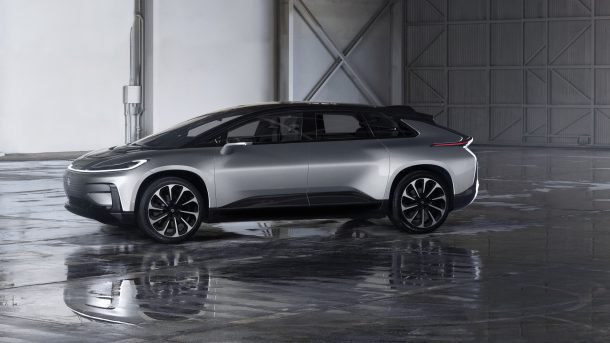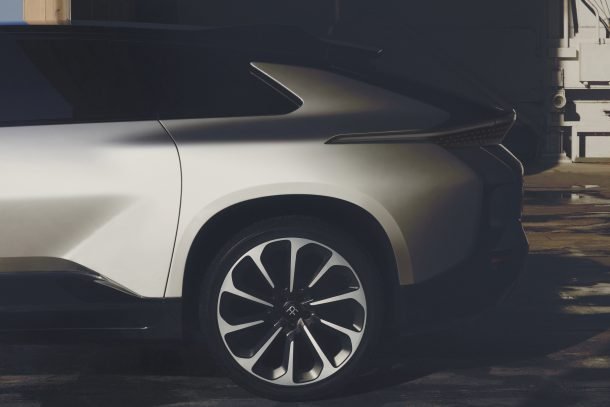Faraday Future's FF 91: A Closer Look at the Biggest Question Mark in the Industry

One year after Faraday Future (FF) revealed its futuristic and racy FFZERO1 concept, the company has pulled back the curtain on its first production car.
The FF 91 is cut from cloth similar to the recently revealed Lucid Air. Both cars are being built by California-based, Chinese-backed companies. And both are scheduled to follow Tesla into the EV Super Sedan market as Trump’s first term hits its midpoint.
The FF 91 will be built on FF’s proprietary Variable Platform Architecture (VPA). The VPA, with its integrated multi-motor powertrain, will enable FF to design vehicles of any style, size, or purpose. And by the numbers, the first car to use VPA will be a giant killer. According to Peter Savagian, VP of Propulsion Engineering, the car will offer the largest, most energy dense battery pack in the industry. The FF 91 will store 130 kilowatt-hours of energy and make up to 1,050 horsepower. It will best the Model S P100D, Tesla’s current range-topping sedan, meaning the FF 91 edges its better known rival in a 0-60 sprint by one-tenth of an unverified second.
In exchange for blistering straight-line performance, the FF 91 does not sacrifice range. FF claims 378 miles of EPA adjusted range, slightly ahead of the current Models S’ verified range and behind Lucid’s optional maximum range claim. The FF 91 features an open charging system that will accept any residential standard, including 110 and 240 volt AC at 1.5, 10, or 15 kilowatt levels. Not only that, but its class leading 200 kilowatt fast charging capability, as well as the prospect of wireless charging, will make the FF 91 easy to live with.
The car is dimensionally similar to a long-wheelbase Mercedes S-Class, though the proportions could not be more different. The FF 91 pushes the greenhouse so far over the front wheels that its abbreviated hood flirts with rakish minivan territory and the roofline extends well over the top of the rear passengers.
The closest analog to the FF 91’s profile may be the defunct Mercedes R-Class. However, the FF 91’s rear glass has a far more gradual slope and terminates at the sharp rear arc of the UFO line — FF’s term for the character line circling the car. Whereas the Lucid Air hues closer to the prevailing industry design trend of providing hatchback-like rear functionality combined with a stealthy roofline that suggests a sedan, the FF 91 embraces its hybrid wagon/hatch form with a pronounced flying buttress D-pillar.
Just how close to production is the design? FF representatives were reluctant to quantify, much less qualify an answer, but several details suggest some design elements may not make it to production.
For example, the B pillars look too broad. These blind-spot-inducing obstructions may be required to support the frameless glass in the doors and access buttons, but they lack elegance. And consistent with other manufacturers in the segment, passenger access is a focal point. FF has chosen to incorporate what we commonly call suicide doors, but the company prefers to refer to as an “entry system”. They point to the autonomous parking/retrieval capability as a practicality enabler, but suicide doors they remain and regulators may have something to say about them. Additional technical risks remain under the skin, where engineers are experiencing challenges getting all 45 computers to talk to each other.
Making the most connected car ever will not be easy.
The product reveal was again scheduled to coincide with the massive Consumer Electronics Show in Las Vegas and was well attended by the press. Approximately 500 media, VIPs, and employees gathered inside an expansive enclosure near the north end of Las Vegas Boulevard.
On stage, FF not only revealed its new car, but ran 0-60 mile times with their benchmark competitors. A Bentley, Ferrari, two Teslas, and finally the FF 91. But in spite of the showmanship and FF’s intricately executed PR teaser campaign, the spotlight was as much on the company as it was on the car. Recent departures of senior executives combined with rumored financial disagreements with vendors put a shadow over the event too big for MC Nick Sampson, EVP of Engineering, to ignore. And in closing he acknowledged as much when he said, “Despite all the nay sayers, the skeptics. We will persist. We will carry on to make the impossible possible.”
Whether FF brings the FF 91, or any car, to market remains to be seen. But they demonstrated live last night their willingness to take risks and keep pushing forward. At the very least, we now know Faraday Future has a real car.
[Images: Faraday Future]

Twenty year auto industry professional. Currently CEO at Turbo International, the premier American manufacturer of OEM replacement turbochargers for the global aftermarket.
More by Seth Parks
Latest Car Reviews
Read moreLatest Product Reviews
Read moreRecent Comments
- Dr.Nick What about Infiniti? Some of those cars might be interesting, whereas not much at Nissan interest me other than the Z which is probably big bucks.
- Dave Holzman My '08 Civic (stick, 159k on the clock) is my favorite car that I've ever owned. If I had to choose between the current Civic and Corolla, I'd test drive 'em (with stick), and see how they felt. But I'd be approaching this choice partial to the Civic. I would not want any sort of automatic transmission, or the turbo engine.
- Merc190 I would say Civic Si all the way if it still revved to 8300 rpm with no turbo. But nowadays I would pick the Corolla because I think they have a more clear idea on their respective models identity and mission. I also believe Toyota has a higher standard for quality.
- Dave Holzman I think we're mixing up a few things here. I won't swear to it, but I'd be damned surprised if they were putting fire retardant in the seats of any cars from the '50s, or even the '60s. I can't quite conjure up the new car smell of the '57 Chevy my parents bought on October 17th of that year... but I could do so--vividly--until the last five years or so. I loved that scent, and when I smelled it, I could see the snow on Hollis Street in Cambridge Mass, as one or the other parent got ready to drive me to nursery school, and I could remember staring up at the sky on Christmas Eve, 1957, wondering if I might see Santa Claus flying overhead in his sleigh. No, I don't think the fire retardant on the foam in the seats of 21st (and maybe late 20th) century cars has anything to do with new car smell. (That doesn't mean new car small lacked toxicity--it probably had some.)
- ToolGuy Is this a website or a podcast with homework? You want me to answer the QOTD before I listen to the podcast? Last time I worked on one of our vehicles (2010 RAV4 2.5L L4) was this past week -- replaced the right front passenger window regulator (only problem turned out to be two loose screws, but went ahead and installed the new part), replaced a bulb in the dash, finally ordered new upper dash finishers (non-OEM) because I cracked one of them ~2 years ago.Looked at the mileage (157K) and scratched my head and proactively ordered plugs, coils, PCV valve, air filter and a spare oil filter, plus a new oil filter housing (for the weirdo cartridge-type filter). Those might go in tomorrow. Is this interesting to you? It ain't that interesting to me. 😉The more intriguing part to me, is I have noticed some 'blowby' (but is it) when the oil filler cap is removed which I don't think was there before. But of course I'm old and forgetful. Is it worth doing a compression test? Leakdown test? Perhaps if a guy were already replacing the plugs...






































Comments
Join the conversation
How likely is it that this behemoth will glide uninterruptedly through dense traffic in self-driving mode? Toyota might 'retaliate' by making its tiny, nimble i-Road self-driving and have it pass the FF from all sides.
It looks.....French NTTAWWT